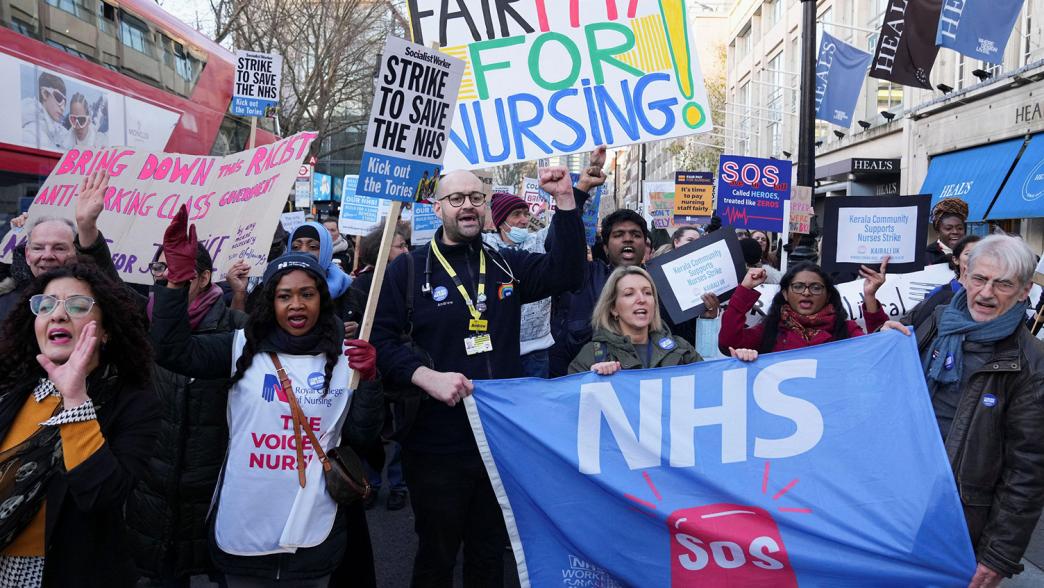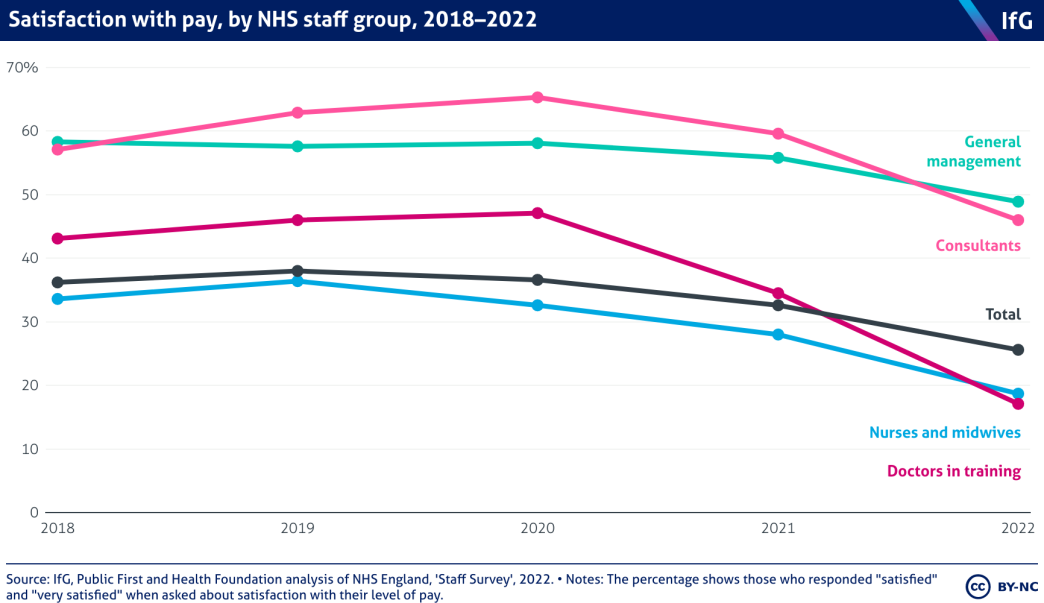Rishi Sunak’s public sector pay offer makes sense but is unlikely to stop the strikes
The government appears to have made a breakthrough in ongoing public sector pay disputes, but big questions remain over where the money will be found.

The government announcement that it will increase public sector pay for teachers, doctors and dentists, civil servants, police, the armed forces, and justice staff by between 5% and 7% in 2023/24 is welcome and implements recommendations from various pay review bodies (PRBs). But while many unions across the public sector recommended that their members accept the pay offer, other key staff groups are likely continue to fight for higher pay.
The government is right to accept the pay review bodies’ recommendations
Rishi Sunak’s decision followed government briefings that it would not accept the PRBs’ recommendations 33 https://news.sky.com/story/union-body-accuses-government-of-playing-politics-amid-reports-6-public-sector-pay-rises-could-be-blocked-12908823 and would instead approve a 3–3.5% pay rise, in line with the amount budgeted at the 2021 spending review.
So the change of position is a positive step. Many services – not least schools and the NHS – are experiencing a workforce crisis, as they struggle to recruit and retain sufficient staff. That would be worsened by another year in which public sector pay failed to keep pace with the private sector, which is expected to be around 6% in 2023. 34 https://www.bankofengland.co.uk/agents-summary/2023/2023-q1 Higher pay alone won’t solve workforce problems, but it will certainly help.

This decision will also bolster confidence with the PRB process. PRBs were criticised in 2022/23 for recommending pay awards that did not account for high levels of inflation, with many unions pointing out that they are not truly independent of government. 36 https://www.politicshome.com/news/article/strikes-gmb-union-nhs-pay-review-body-farcical This set of recommendations (and the government’s reported displeasure with them) could help to ease some of that concern. It also shows the relative power of PRBs; it would have been politically costly for the government to reject their recommendations, particularly after they relied so heavily on PRB recommendations to justify low pay awards in 2022/23.
Unfunded increases will require cuts to services
The government has made clear that departments will have to fund pay increases out of existing settlements. Sunak encouraged departments to find “efficiencies” to pay for uplifts, but as previous Institute for Government work shows, more than a decade of austerity, the coronavirus pandemic, and the inflation crisis means there is no more fat to trim.
NHS budgets were set in the anticipation of 3.5% pay rises in 2023/24, meaning that additional funding for the doctors’ pay award and the previously agreed 5% increase for AfC staff will require cuts elsewhere in the service. That will not be easy. The NHS is already struggling to stick to the spending envelope, with a third of the NHS’s integrated care systems (ICSs) failing to submit balanced budgets. 49 https://www.lgcplus.com/services/health-and-care/revealed-the-icss-that-refused-to-set-breakeven-plans-02-06-2023/ The one method the government has announced for funding the award – an increase in the surcharge for health workers’ visas – may also hurt one of the service’s primary sources of staff. 50 https://www.theguardian.com/society/2023/jul/14/nhs-cannot-afford-to-finance-pay-rises-from-existing-budgets-hospitals-say
The government has said that the increase for teachers’ pay is fully funded – a commitment which saw teaching union chiefs appearing alongside Sunak at the press conference where he announced the pay rise. That money is coming from the reprioritisation of the Department for Education’s underspends – the majority reportedly being unspent money that was earmarked for the National Tutoring Programme 51 https://www.twinkl.co.uk/news/teacher-pay-for-2324-your-faqs-answered – and will mean schools receive £525m more funding in 2023/24 and £900m more in 2024/25. 52 https://educationhub.blog.gov.uk/2023/07/13/teacher-strikes-everything-you-need-to-know-about-the-2023-24-teacher-pay-award/ But that money is only a one-off allocation while teachers’ salaries are an ongoing liability, storing up problems for the next spending review.
The government’s existing spending plans beyond 2024/25 were already extremely tight, providing services with 1% real-terms increases until 2027/28. 53 https://obr.uk/box/the-implications-of-the-governments-departmental-spending-plans/ Both parties have indicated that they intend to stick to those plans, meaning that these pay increases will require cuts. That will likely mean stopping transformation programmes, leaving vacancies unfilled, or reducing service provision overall – all decisions that would save money in the short term, but would likely add to costs in the longer term.
The pay deal does not end industrial disputes
The government will hope that this unexpectedly generous pay offer will bring an end to the wave of industrial action that has gripped public services over the last year. But first unions have to put the award to members, who must then vote in favour of ending strike action.
Teachers look the most likely to end the strikes, with their unions recommending that members accept the pay deal – though there is still some opposition from factions within teaching unions. 54 https://www.theguardian.com/education/2023/jul/16/opposition-grows-among-teachers-to-65-pay-offer-in-england# Other services look more complex.
In the NHS, the offer of 6% for doctors (with an extra consolidated £1,250 for junior doctors, that will add an additional 2.1% to 4.3%, depending on the stage of training 55 https://www.gov.uk/government/news/nhs-staff-receive-pay-rise ) is still well below the 35% that the British Medical Association (BMA, the union representing junior doctors) claims is needed to restore junior doctors’ pay to 2008 levels. 56 https://www.bma.org.uk/our-campaigns/junior-doctor-campaigns/pay/pay-restoration Indeed, the BMA have already warned that the offer is not enough to put an end to strike action, 57 https://www.bmj.com/content/382/bmj.p1624 and announced another round of strikes by consultants after the pay offer. 58 https://www.theguardian.com/society/2023/jul/17/nhs-consultants-england-strikes-august-bma Given Sunak’s firm line that “there will be no more talks on pay”, 59 https://www.gov.uk/government/speeches/pm-statement-on-public-sector-pay-review-13-july-2023 this sets the scene for ongoing strike action from doctors. If that transpires, it will seriously jeopardise the government’s ambition to bring down waiting lists before the next election.
Ambulance workers and nurses are two staff group that have been notable for their absence from the announcement. This is because they are not eligible for the 6% pay rise, having accepted a 5% pay rise in 2023/24 as part of their deal that ended their strikes in March this year. 60 https://www.nhspay.org/nhs-pay-offer At the time, that looked like a good deal, with staff receiving a pay rise that was 1.5 percentage points above the 3.5% that PRBs were expected to recommend. But many will be feeling aggrieved at other staff groups being given a bigger pay award without having first undertaken industrial action. The Royal College of Nursing (RCN) have already written to Steve Barclay asking why “nursing deserves the least”, and threatening a return to strike action if nurses’ pay is not uplifted in line with other staff groups.
Sunak has reason to celebrate this week, but his pay offer still leaves many questions unanswered and does not guarantee an end to industrial action.
- Topic
- Public services
- Political party
- Conservative
- Administration
- Sunak government
- Public figures
- Rishi Sunak Jeremy Hunt
- Tracker
- Performance Tracker
- Publisher
- Institute for Government